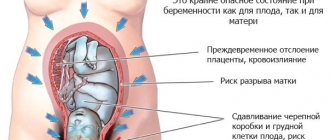Baby
The 17th week of pregnancy is marked for the baby by an active increase in the mass of his muscles, their gradual strengthening, which allows him to move in the tummy more intensely and variedly. Quite frequent movements of the limbs help the child train muscles and also develop the joints of the knees and elbows. At this stage, the hands are still clenched into fists, rarely unclenched, and only for the purpose of grasping the umbilical cord or sucking a finger. Until 17 weeks, the fetal head was practically motionless, dropped quite low, and the chin was tightly attached to the chest. Strengthening the muscles of the back and cervical region at this stage allows the child to raise his head to an almost vertical position.
Internal organs continue to develop and improve. Their structure only becomes more complex, which contributes to the expansion of functionality. Their preparation will allow you to begin normal, full functioning after the baby is born.
It is important to note the changes that occur in the vascular system and heart of the fetus. The nerve plexuses that surround the heart give rise to the formation of the conduction system; Its uniqueness lies in the fact that the heart does not need signals from the outside to work. All human internal organs obey the central nervous system. The brain sends certain instructions according to which each of the organs works. The heart, in turn, functions with the help of command signals that arise within itself and cause it to contract. The exclusively autonomous mode of operation of the heart allows it to be independent of the level of central nervous system activity throughout a person’s life.
The 17th week of pregnancy is also characterized by the formation of the respiratory system, namely, the strengthening of the lung muscles. Active respiratory contractions resemble inhalation and exhalation and thereby strengthen the muscles of the chest. The formation of the alveolar apparatus of the lungs also occurs. Alveoli are presented in the human body in the form of small bubbles, which are located on the surface of the respiratory apparatus and are responsible for gas exchange. Each breath helps saturate the blood with oxygen. At the 17th week, the alveoli are in a compressed state, but immediately after birth, with the first breath, they will straighten out and be ready for normal functioning.
The weight of the fetus at this stage is about 150 g, and the body length is 12-13 cm.
The structure of the external (and internal) genital organs changes
- The external genitalia become swollen and hyperemic. Cyanosis of the mucous membranes of the vaginal part of the cervix, vagina and its vestibule occurs, which indicates vasodilatation and blood stasis, facilitating serous permeation of the tissues necessary for the deposition of nutrients at the site of attachment of the fertilized egg to the uterine wall.
- The vagina expands and lengthens somewhat during pregnancy. The walls of the vagina are swollen and thickened. The discharge becomes more abundant, mucous in nature, milky white or yellowish in color with an acidic reaction. In a healthy pregnant woman, the vagina has I-II degrees of cleanliness.
The uterus changes the most during pregnancy compared to other organs.
Its size increases during pregnancy in all respects:
- weight - from 50-100 g to 1-2 kg!!!
- length - from 7-9 cm to 50 cm,
- volume - 500 times, reaching 2-3,000 cm3 (liters) or more.
Accordingly, changes occur in all tissues, blood supply and innervation of the uterus:
- The shape and position of the uterus changes during pregnancy. As the uterus grows, it emerges from the pelvis into the abdominal cavity, rising in the 9th month of pregnancy to the xiphoid process. The shape of the uterus is asymmetrical due to the bulging of the part where the placenta is attached.
- Thin arteries and veins of the uterus turn into powerful trunks, which become corkscrew-shaped, tortuous, which allows maintaining normal blood supply during pronounced changes in the uterus during pregnancy and during contraction of its muscles during childbirth.
- The volume of blood circulation in the uterus during pregnancy increases tens of times, providing uteroplacental blood flow, which is carried out according to the principle of blood supply to vital organs and remains relatively optimal even under various stresses (blood loss, anemia). This ensures the survival of the fetus in extreme situations.
- The receptor system of the uterus changes: during pregnancy, the sensitivity of the uterus to stimulating factors decreases, before childbirth, the excitability of the uterus increases, some of the nervous structures are lost in order to reduce pain information from the uterus during childbirth.
With the appearance of the placenta, a pregnancy dominant arises in the cerebral cortex, which ensures clear coordination of the functions of all organs and systems in the interests of the developing fetus.
Women note a decrease in performance, increased drowsiness, or vice versa, they are irritated, they have nausea, drooling, periodic vomiting, which is classified as mild and the occurrence of which corresponds to the phase of functional changes in the nervous system.
Pregnant women have increased suggestibility and self-hypnosis, which is taken into account when conducting psychoprophylactic preparation for childbirth.
Phenomena of paresthesia, neuralgic pain, spasms of muscle groups, numbness of the fingers and other disorders may occur. Increased excitability of peripheral nerves is also manifested by increased knee reflexes.
With all this, sexual excitability decreases , and you, dear husbands, must be prepared for this. No need, under no circumstances!!! (remember about increased suggestibility and self-hypnosis) do not show your grievances that your wife is cold and inattentive to you, which means she has stopped loving you. She still loves you, she is already carrying your child and she has a dominant in her cerebral cortex - to endure pregnancy at all costs. And there is no escape from this.
- In a pregnant woman, the functions of some analyzers change - hearing, vision, smell!!! A pregnant woman's sense of smell can become so strong that the woman will react to the lightest (hardly perceptible) odors.
Please keep in mind, dear men, when a woman feels bad, feels sick, and the world is generally in shades of grey, for some reason unhappy thoughts come into her head, which can lead to a deterioration in her condition and, as a consequence, to termination of pregnancy.
During pregnancy, changes affect other organs as well.
The adrenal glands increase in size during pregnancy due to cortical hyperplasia, and the glucocorticoid and mineralocorticoid function of the adrenal glands increases accordingly.
Strengthening the function of the adrenal cortex during pregnancy is aimed at increasing protective and adaptive mechanisms, including during childbirth.
The thyroid gland increases in volume and function increases. Goiter in pregnant women is observed, especially in areas endemic for goiter (little iodine in soil and water) and hyperthyroidism without thyrotoxicosis. Strengthening the function of the thyroid gland is associated with the influence of placental hormones on it. Clinical thyrotoxicosis does not develop due to increased binding of free hormones by plasma proteins. The protein-bound form of the hormone is subsequently utilized by the fetus and the mother’s body, since the need for it increases with the development of pregnancy, before the onset of fetal thyroid function.
The parathyroid glands (calcium metabolism) undergo hypertrophy, their functional activity increases due to the increased need for calcium, which is a plastic material for the formation of the musculoskeletal system of the fetus. If there is insufficient intake or impaired absorption, the fetus receives calcium from the tissues of the mother’s body (bones, teeth), which can manifest itself as osteoporosis, fragility and dental caries. During pregnancy, the concentration of calcium in the blood increases. The content of phosphorus compounds, iron and a number of microelements (cobalt, iodine, manganese, copper) also decreases in the blood plasma. The deficiency of these substances is due to the needs of the fetus and increased metabolic reactions, the enzyme systems of which include some of the micro- and macroelements.
Pancreas – strengthening the function of the insulin-producing apparatus. As a result, carbohydrates are absorbed very well and are deposited in the mother’s liver and in the tissues of the fetus. Women with diabetes always give birth to large children due to the utilization of excess carbohydrates by the fetus. Some pregnant women experience glucosuria (sugar in the urine), which is not pathological and manifests itself with normal or even low carbohydrate levels in the blood.
The pituitary gland in pregnant women increases in volume and is difficult to fit in the sella turcica; hyperproduction of growth hormone (GH) is observed, which, penetrating the placenta, stimulates the growth of the embryo. This hormone also affects the lactogenic function of the mammary gland, causing in some cases an enlargement of the nose, lips, and fingers.
Future mom
The abdomen is actively growing, and the fundus of the uterus occupies a position midway between the navel and the woman’s pubis. The normal weight gain for a given week is 5 kg. Also, the 17th week of pregnancy is characterized by an increase in the total blood volume of the expectant mother, because her fetus needs intensive nutrition. You may also notice a rapid heartbeat due to large amounts of blood passing through the heart. Additional heart contractions or tachycardia may not be felt at all by the pregnant woman or may cause her discomfort. In case of active manifestation of tachycardia, you should seek help and advice from your gynecologist or cardiologist, who can identify the symptoms of heart disease in a pregnant woman, as well as prescribe the correct treatment to maintain normal well-being.
A sharp increase in the volume of blood in the usual circulation can cause the expectant mother to have an increased level of bleeding gums, as well as nosebleeds. Increased load on the capillaries often leads to a malfunction in their operation. The mucous membranes of the nose and mouth are especially vulnerable. Properly selected vitamin complexes will correct this situation and strengthen the walls of blood vessels. In addition, doctors recommend using a soft toothbrush for hygienic purposes, which will reduce the risk of bleeding gums. It is also recommended to rinse the nasal passages with solutions such as AQUAMARIS, PHYSIOMER, SALIN. You can prepare a similar solution at home if you wish. For this you will need 1 teaspoon of salt and a glass of water. All ingredients should be mixed before use. If these simple recommendations are ineffective and bleeding becomes more frequent, you should seek help from a specialist.
Reasons for changes in stool color during pregnancy
The reasons for dark, almost black coloring of stool during pregnancy vary. In some cases, you should immediately rush to see a gastroenterologist, especially if you have a history of chronic diseases of the gastrointestinal tract. However, more often you just need to remember what foods were in your diet the day before.
Doctors reassure: almost always this phenomenon can be eliminated by selecting the right menu. However, if the stool turns black, you should definitely find out the reason. Situations that can be dangerous:
- varicose veins of the esophagus;
- gastrointestinal ulcers;
- neoplasms;
- injuries to the mucous membrane of the digestive system due to rough food.
Hormonal changes in the body
The first trimester is characterized by complete restructuring in the female body. From now on, everything that happens to the expectant mother in labor is related to the protection of the fetus and is aimed at its harmonious development. It’s not easy for women, because they often suffer from moderate or severe toxicosis at the beginning of pregnancy. It is associated with sudden vomiting, heartburn, decreased appetite, constipation or diarrhea.
Black-colored feces are often added to this list. Doctors attribute this to hormonal changes, which do not require medical intervention. However, there are situations when, in the event of such a phenomenon, it is best for the expectant mother to be under the supervision of reliable specialists.
Food
Often the stool takes on an unnatural color due to the food that was in the diet the day before. If you detect black feces, you should remember what foods could cause the unusual phenomenon. Repainting the intestinal contents:
- drinks – coffee, sparkling waters, powdered red wines;
- meat products – blood sausage, beef liver;
- fruits - blackberries, blueberries, blueberries, pomegranate, dark grapes, chokeberry, prunes;
- vegetables - beets, tomatoes.
The above foods contain pigments that are only partially absorbed by the intestines. The rest is excreted undigested, causing the stool to have an unusual dark hue. If you exclude these foods from your diet, everything will soon return to normal.
Certain medications
The cause of anxiety about black stool in a pregnant woman is often the medications prescribed by the doctor. Usually a specialist warns about this; you can also read about the side effect in the instructions for the medications. The following have the ability to give intestinal contents a black color:
- Activated carbon;
- multivitamins;
- products with iron, bismuth;
- long-term use of anti-inflammatory drugs.
Activated charcoal is taken by expectant mothers in the hope of reducing the symptoms of toxicosis. Sorbent components are eliminated through the digestive tract in full, giving stool an unnatural color.
Dark stool is often observed during pregnancy due to taking the drug Elevit Pronatal. This multivitamin complex contains iron, which is not completely broken down in the digestive tract. Its remains are passed out in feces. Black stools when taking any anti-anemia drug are normal during pregnancy.
It happens that in the first trimester of pregnancy the expectant mother took certain vitamins, but stopped taking them. Some time after resuming the course in the second trimester, she was alerted by black feces. There is nothing to worry about in this case. At first, the body completely absorbed the iron, but it became saturated, and now some of it is excreted with undigested food. You should take the course of vitamins to the end.
Baby
At the 18th week, the child weighs about 200-250 g, and its length is approximately 20 cm. During this period, the structure of the brain becomes more complex, and its total mass also increases; nerve fibers are covered with myelin, a special fatty sheath that promotes accelerated nerve conduction. nerve impulses. After the birth of the child, this shell will allow the child to respond to stimuli from the outside.
The appearance of the fetus already slightly resembles a newborn baby and is actively approaching this state. Facial features become more and more distinct, the ears, which were previously tightly pressed to the head, are straightened, the middle ear is formed, and its perception is also improved. At this stage of pregnancy, the baby can already perceive stimuli from the outside and respond to various kinds of sounds. The noises that occur in the mother’s body due to the active work of the internal organs are completely normal and familiar to him, and also contribute to the training of auditory perception.
It is impossible not to note the intensive work of the fetal endocrine system. At 18-19 weeks, the release of “baby” hormones is large enough that even the mother’s body can be supplied with them. If a woman’s body lacks its own hormones, they are compensated for by children’s hormones, and the mother’s condition returns to normal.
Dear men, loving husbands!
Remember that your pregnant wife is an “unusual” person the entire time she is carrying your child. That is why a loving husband should not allow his wife to overwork herself with housework. A pregnant woman needs to create favorable conditions so that she can safely bear and give birth to a child, i.e. so that her body can qualitatively adapt to changing conditions as the pregnancy progresses (the baby grows, develops, eats, “breathes,” etc. - conditions are constantly changing).
If a pregnant woman’s body cannot adapt normally, then she will experience various unfavorable conditions, primarily for the child. For a woman, these are also unfavorable conditions. In especially severe cases, pregnancy is sacrificed to save the woman, because... terminating a pregnancy in this condition immediately leads to recovery (conditionally to recovery), but your child will no longer be born.
Always take care of women! And especially during pregnancy!
Future mom
This week, some mothers feel the first movements of their baby. Most often, women for whom this is the first child can feel fetal movements at 19-20 weeks. At earlier stages, namely, at 16-18 weeks, those women who already have their own children, and who are also quite thin with a slight layer of fat under the skin, notice movement.
At the first stages, the movements will be rather weak, brief and episodic, but after a short period of time they will become more distinct and more frequent. The nature of the shocks can be different:
- touching;
- light tremors;
- twitching;
- rolling.
For a woman, the first kicks of her baby are very expected. This is an exciting moment that will allow the expectant mother to remember these pleasant sensations with trepidation, and also as proof of her connection with the child. At the 18th week, the baby’s movements are quite chaotic, varied and appear while the baby is awake. With emotional stress, they can become more intense. Also, the child may report an insufficient amount of oxygen, which occurs due to the woman’s lack of movement, insufficient time spent outdoors, as well as being in the same position for a long time (driving a vehicle, at work). Most of the time at this stage of development the fetus sleeps.
Baby
The 19th week is characterized for the fetus by intensive growth of the limbs in length, an increase in size, and a slowdown in head growth. Its length is already 25 cm, and its weight is approximately 250-300 g. The child changes greatly in appearance, his body no longer looks disproportionate.
The fat under the skin allows the relief of the body to change slightly and become rounded. This brown fat is formed at 19-20 weeks. After birth, it is he who will perform the function of thermoregulation and protect the child from hypothermia or overheating. With age, this fat disappears and remains only in certain places: in the thickness of a person’s cheeks, kidney area, under the armpits, and shoulder blades.
At this stage, the formation of permanent teeth, which are located in the dental plate under the rudiments of milk teeth, and the maturation of the brain also occur. Special processes allow connections between neurons to be established. Cells intertwine with each other and create a whole system for transmitting impulses, ensuring the synchrony of the brain. The structures responsible for touch, taste, vision, hearing, and smell are actively developing.
Changes also occur in the hematopoietic system. The spleen is connected to the process of formation of blood cells, produces leukocytes, the task of which is to protect the child’s body from external and internal factors. Until 19-20 weeks, the fetal blood consisted only of red blood cells, and at this stage its composition changes sharply and approaches the composition of the blood of a newborn.
Future mom
The expectant mother's belly is actively growing, and the fundus of the uterus is already located up to 2 cm below the navel. The weight gain is about 3-6 kg and is distributed proportionally between the placenta, uterus, fetus, and amniotic fluid. The weight of the fetus is only a tenth of the total added weight.
Due to the intensive growth of the uterus, a woman may feel discomfort. Often this condition manifests itself when changing body position, bending to the sides, or walking. The nature of pain may vary. These can be nagging, sharp, sudden pains that occur on one or both sides. Stretching of the ligaments that are attached to the side walls of the uterus and pelvic bones in order to fix the uterus occurs quite actively. A woman’s uterus is, as it were, in a suspended state thanks to this ligamentous apparatus. When the ligaments are stretched during changes in the position of the uterus, pain occurs.
This type of pain is completely normal and characteristic of this period of pregnancy. In critical situations, a gynecologist may recommend that a woman take antispasmodics, which will help relax the uterus, as well as eliminate the problem of pain almost completely. At the 19th week, it is important for the gynecologist to exclude such risks of pregnancy complications as the threat of miscarriage and uterine hypertonicity. If one of these risks is detected, the expectant mother will be prescribed hospital treatment.
Baby
The body length of the baby at this stage is 28 cm, and the weight is about 340 g. Before this week of pregnancy, the length of the fetus was measured by calculating its length from the crown to the tailbone. After the 20th week, the specialist includes in the concept of growth the length of not only the body, but also the lower limbs.
At this stage of development, the child is quite active, makes numerous movements, since there is enough space in the uterus for him to somersault, push off from the walls, as well as other movements. The baby may smile, grasp the umbilical cord, touch himself, frown, and close his eyes. His facial expressions are quite developed and more pronounced than before.
The skin becomes dense, actively covered with vellus hairs and special lubricant. A large amount of this lubricant is found in the folds. This lubricant prevents the risk of mechanical friction, has bactericidal properties, and ensures optimal passage of the fetus through the mother's birth canal during childbirth.
It is impossible not to note the intensive development of the gastrointestinal tract. Small portions of amniotic fluid, which the child swallows, wash the walls of the intestines and stomach, lead to peristalsis training, and promote intestinal contraction.
At the 20th week, amniotic fluid is processed. The first stool formed in the child’s body is meconium. It has a dark green color. It consists of mucus, water, epithelial cells, and bile. Meconium accumulates in the intestinal lumen. On the first day of birth, it comes out.
What does it mean if the stool is green?
What color should a pregnant woman's stool normally be? Like any person - brown. A slight change in color (darker or lighter) is acceptable as the liver is under stress.
Possible reasons for different colored stools are listed below:
- Light. Excessively light-colored stools indicate impaired fermentation and insufficient bile production. They are observed with hepatitis, the presence of stones in the bile ducts. In pregnant women, this phenomenon occurs as a result of consuming dairy and plant products.
- Green. It is observed when eating mainly plant foods rich in chlorophyll (colors the stool green). Other, more serious situations are intoxication, tumors, inflammatory processes in the intestines. Green stool can be observed with an intestinal infection, which should be treated under the supervision of a doctor. Black-green feces are evidence of intestinal dysbiosis, the death of beneficial microflora in it.
- Red. Observed after eating foods with a high content of bright coloring pigments. It can also be caused by internal intestinal bleeding.
- Yellow. Characteristic of celiac disease (atrophy of the mucous membrane of the small intestine), pathologies of the pancreas.
Future mom
The 20th week marks the end of the first half of a woman's pregnancy. Starting from the next weeks, the load on the body of the expectant mother only increases. This fact can be explained by the active development of the fetus in the womb.
The pregnant woman's abdomen increases significantly, and the fundus of the uterus is already at the level of the navel. During this period, a woman may complain of symptoms of shortness of breath: after all, the uterus is already beginning to put pressure on the lungs. Also characteristic of this week is increased urination. Squeezing the bladder leads to frequent urge.
Discharge from a woman’s vagina also increases. Large blood flow contributes to increased secretion production. The discharge may be mucous or white. It should also be noted that they should not have an unpleasant odor or cause itching or burning. Changes in a woman’s discharge are a reason to consult a doctor, because this can signal the expectant mother about the presence of various types of diseases. Curdled, thick, yellow discharge with an unpleasant odor can signal the presence of sexually transmitted infections and their exacerbation, microflora disturbances, and the manifestation of thrush. Pregnant women are prone to colpitis, since their mucous membrane becomes more attractive to microbes, promotes their active reproduction and thereby increases the risk of contracting an infection to the fetus.
That is why, at the 20th week, women are required to undergo screenings, a smear of secretions for flora, and also undergo a diagnosis of sexually transmitted infections. If any signs of deterioration in the pregnant woman’s condition are detected, the doctor may prescribe further examination and a course of treatment.
Prevention of stool disorders
Preventative measures that will help prevent unexpected changes in stool color include eliminating possible symptom provocateurs. This includes correcting nutrition, maintaining personal hygiene, and controlling chronic diseases. Treatment of gastric and intestinal ulcers should be carried out at the planning stage of conception. It is difficult to control hemoglobin levels, and if iron supplementation is necessary, the change in stool color will not affect the female body.
Is it dangerous when a pregnant woman has black stool? If a woman is healthy, nothing bad will happen to the mother and the fetus. Staining as a result of internal pathologies and infections requires close attention and correction.










